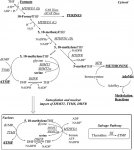Bluebell
Senior Member
- Messages
- 392
LaurieL : Mine are similar to yours. But several of the DHFR SNPs have exactly the same prevalence in the same sample groups, so are probably inherited as a chunk. One such cluster is red, and the other is green. Our differences from the Richvank genotype are orange.
RSID........ALLELE.....RICH...LAURIEL....VAL...
rs7387......A or T...TT (-/-) AT (+/-) AT (+/-)
rs1643659...C or T...TT (-/-) CT (+/-) CT (+/-)
rs1677693...G or T...GG (-/-) GT (+/-) GT (+/-)
rs1643649...C or T...TT (-/-) CT (+/-) CT (+/-)
rs11951910..C or T...TT (-/-) CT (+/-) TT (-/-)
rs865646....G or T...GG (-/-) GT (+/-) GT (+/-)
rs13161245..A or G...AA (-/-) AC (+/-) ?? (?/?)
rs10072026..C or T...TT (-/-) TT (-/-) TT (-/-)
rs11490741..C or T...CC (-/-) CC (-/-) CC (-/-)
rs863215....C or T...CC (-/-) CT (+/-) CT (+/-)
rs1478834...A or C...CC (-/-) AC (+/-) AC (+/-)
rs1650697...A or G...AA (-/-) AG (+/-) AG (+/-)
So we have the same "red" and "green" groups, which are different from Richvank's, as well as rs7387 and rs1650697. Our only difference from each other is that I have the Richvank version of rs11951910.
Valentijn, I believe that you misunderstood what NanDixon said about Richvank's results.
You have indicated in your table here that Rich's result for rs1650697 was AA. However, that is what NanDixon said HER result was. She stated that rs1650697 was the only one where she differed from Rich's.
She also stated that Rich's results were all homozygous and all "-/-", so that probably means that Rich's result on rs1650697 was GG, the only other possibility if NanDixon's "+/+" AA homozygous result was different from his.
In her original post, she wrote: "....his results appear to be completely normal (homozygous -/- throughout). Mine are identical to his with only one exception: the SNP rs1650697 (aka C35T or G-437A) that overlaps with a coding region for the gene MSH3 is homozygous (+/+) for the variant alleles (AA)....
Below are my results for people to compare to theirs.... rs1650697 AA (+/+)."
I have not tried to search for the thread where Rich reported his original 23andme results, but that would be the best way to make sure, of course.

